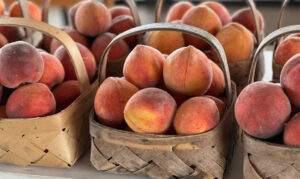When I was 13, I begged Mama to let me have a Tupperware party. It took some work but finally she agreed.
Out in the country where we lived, people tended only to socialize at church because they were too busy making a living to dilly dally. I had just reached the age where I had tremendous zest for cooking and all things related to it. Mama was still using leftover loaf bread wrappers, Cool-whip bowls and tin foil to store leftovers.
I, though, wanted a pretty set of three Seal and Serve bowls which came in orange, harvest green and yellow. And, if possible, a set of Wondelier bowls.
We scrubbed the house, invited everyone from church and close by, then Mama made punch, a fresh coconut cake and deviled egg sandwiches. Once Mama set her mind to something, she’d make a success out of it, no matter what it took.
We sold so much Tupperware that night that we got, as hostess gifts, both sets of bowls, measuring cups, Popsicle trays, a lettuce crisper (a pure genius invention), a deviled egg carrier (my niece still uses it despite its color being out-of-date harvest gold) and salt and pepper shakers.
That party marked the beginning of my lifelong love of Tupperware. Now, stores sell cheaper, knockoff brands but I remain loyal to Tupperware.
Several years ago, my niece, Nicole, hosted a Tupperware party to help a church friend who had just started selling it. I was the first to arrive. The Tupperware representative did a game of Tupperware trivia which I easily won.
When she asked who was the woman who came up with the marketing idea of Tupperware home parties, I answered before the question was finished.
“Brownie Wise.”
Disbelief covered her face and someone asked, “HOW do you know the answers to all these?”
“I just watched a PBS documentary about Tupperware,” I replied cheerfully.
“Who watches a documentary on Tupperware?” someone asked sarcastically.
For the record, that documentary called “Tupperware!” won a George Foster Peabody award, the most prestigious honor in television. It’s excellent.
Every piece of Tupperware I ever bought – or inherited from Mama – I still have and use. It has a lifetime guarantee so I know that if I contacted them, they would replace the onion keeper (another genius idea) because the lid broke away from the bottom. But it still works fine and, besides, it’s a vintage piece that was one of my first purchases.
In the Clint Eastwood movie, “Richard Jewell,” about the poor man who endured severe law enforcement scrutiny in conjunction with the Atlanta Olympics bombing, the FBI stormed into the apartment where he lived with his mama. She, played by Kathy Bates, fretted tearfully as they hauled away her Tupperware.
I understood her agony.
When the FBI terminated their investigation, all that had been seized was returned to them including the Tupperware. With a black magic marker, each piece had been numbered as a piece of evidence. (That had to be done by a man because a woman would never have been so irreverent).
Then, she really cried, knowing that the marker would never come out so she wailed about 30 years of Tupperware being ruined. Kathy Bates should win awards for the apt depiction of such agony.
I shudder to think of such.
Jewell, fittingly, won settlements from some who cast shadows on his name. His mama continued to worry about her Tupperware and pursued it. According to the book, “Suspect,” she received a $2,500 check from the federal government to compensate for the Tupperware and other ruined items.
But you know, you just can’t place a price on the memories that cling to 30 years of Tupperware. Those are priceless.
The ironic twist in all of this? Kathy Bates was the narrator of the PBS documentary.
I think that seals it up real good.
[Ronda Rich is the bestselling author of “There’s A Better Day A-Comin’.” Visit www.rondarich to sign up for her free weekly newsletter.]












Leave a Comment
You must be logged in to post a comment.